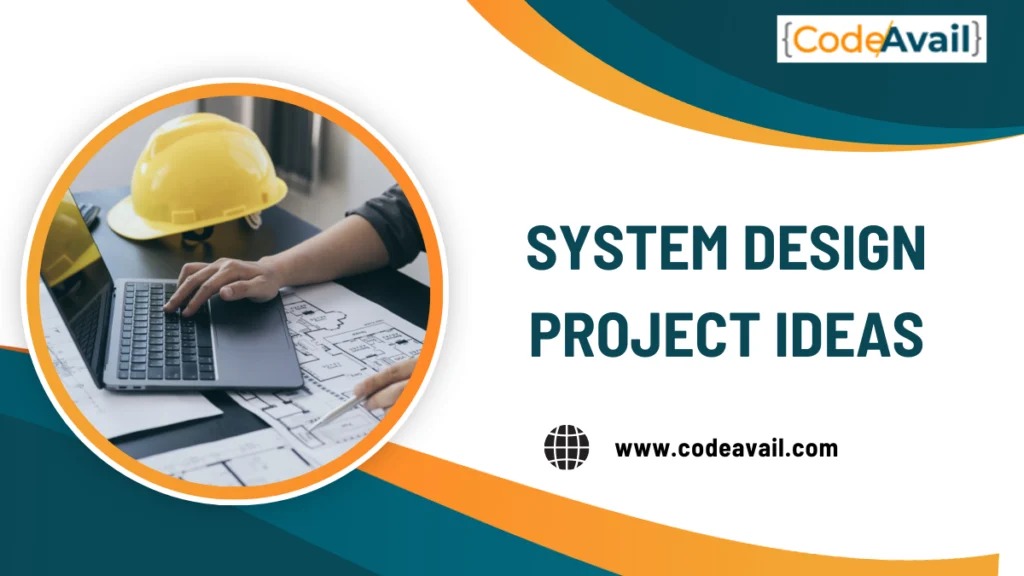In education, system design plays a crucial role in bridging theoretical knowledge with practical applications. Practical skills are paramount in system design, as they empower students to tackle real-world challenges with confidence and efficacy.
Utilizing project ideas in system design not only enhances students’ problem-solving abilities but also cultivates creativity and innovation.
These projects are invaluable learning experiences, providing students with hands-on opportunities to apply theoretical concepts to tangible solutions.
In this blog, we will explore various system design project ideas specifically tailored for students. From developing scalable web applications to optimizing database systems, we aim to inspire and equip students with the tools and knowledge to excel in their academic and professional endeavors.
What is System Design?
Table of Contents
System design is the process of creating and defining the architecture, components, and interactions of a system to fulfill specified requirements.
It involves analyzing complex problems, breaking them into manageable components, and designing solutions that integrate seamlessly to achieve desired functionality.
In essence, system design encompasses the conceptualization and implementation of systems across various domains, including software engineering, hardware development, and organizational management.
It requires careful consideration of factors such as performance, scalability, reliability, and maintainability to ensure the resulting system meets user needs effectively and efficiently.
| Also Read: Vue JS Projects for Beginners |
Criteria for Selecting a System Design Project
Selecting a system design project involves considering various factors to ensure it aligns with your goals, resources, and constraints. Here are some criteria to help you evaluate and choose a suitable system design project:

1. Define Objectives
Clearly outline the goals and objectives of the project, including the problem statement and desired outcomes.
2. Assess Feasibility
Evaluate the feasibility of the project in terms of available resources, time constraints, and technical expertise.
3. Consider Relevance
Ensure the project aligns with your academic curriculum, career aspirations, or personal interests to maximize engagement and motivation.
4. Scope Definition
Define the scope of the project, identifying boundaries and limitations to prevent scope creep and maintain focus.
5. Research and Innovation
Explore innovative ideas and leverage existing research to add value and relevance to the project.
6. Stakeholder Engagement
Involve relevant stakeholders such as instructors, mentors, or industry professionals to provide guidance and support throughout the project lifecycle.
7. Risk Analysis
Identify potential risks and challenges associated with the project and develop mitigation strategies to address them effectively.
8. Evaluation Criteria
Establish clear criteria for evaluating project success, considering factors such as functionality, scalability, usability, and impact.
9. Ethical Considerations
Ensure the project adheres to ethical standards and principles, respecting privacy, security, and social responsibility.
10. Documentation and Communication
Document project requirements, progress, and outcomes comprehensively and maintain regular communication with stakeholders to ensure alignment and transparency.
Simple System Design Project Ideas For Students
Here are some simple system design project ideas suitable for students:
1. To-Do List Application
Develop a simple to-do list app that allows users to add, edit, and delete tasks. Focus on user-friendly interface design and basic functionality to help students understand database management and user interaction.
2. Weather Forecasting System
Create a weather forecasting system that retrieves data from an API and displays current weather conditions and forecasts for selected locations. This project introduces students to API integration, data parsing, and visualization techniques.
3. Library Management System
Design a system to manage library resources, including book cataloging, borrowing, and returning. Students can learn about database management, user authentication, and transaction processing through this project.
4. Online Food Ordering System
Build an online platform for ordering food from local restaurants. This project teaches students about e-commerce functionalities such as user accounts, product listings, shopping carts, and payment processing.
5. Student Attendance Tracker
Develop a system for tracking student attendance in classrooms or events. Students can learn about database management, user authentication, and data visualization while creating this application.
6. E-commerce Website for Handmade Crafts
Create a marketplace for buying and selling handmade crafts. Students can gain experience in website development, database management, and payment integration while showcasing artisan products.
7. Fitness Tracker App
Design a mobile app that tracks users’ fitness activities, including workouts, calories burned, and progress charts. This project introduces students to mobile app development, data tracking, and visualization techniques.
8. Online Quiz Platform
Build an online platform for creating and taking quizzes on various subjects. Students can learn about database management, user authentication, and quiz generation algorithms while developing this application.
9. Movie Recommendation System
Develop a movie recommendation system based on user preferences and viewing history. This project involves data analysis, machine learning techniques, and user interface design to provide personalized recommendations.
10. Expense Tracker
Create an expense-tracking application to help users manage their finances. Students can learn about database management, user authentication, and budgeting functionalities while developing this project.
11. Event Management System
Design a system for organizing and managing events, including scheduling, attendee registration, and communication. This project introduces students to event-driven programming, database management, and user interface design.
12. Travel Planner Application
Develop a travel planning app that helps users organize their trips, including itinerary creation, accommodation booking, and activity recommendations. This project teaches students about API integration, geolocation services, and user experience design.
13. Online Banking System
Create a simulation of an online banking platform with features such as account management, fund transfers, and transaction history. This project introduces students to security protocols, database management, and financial transactions.
14. Recipe Sharing Platform
Build a platform where users can share and discover recipes, including search functionality, rating systems, and ingredient lists. Students can learn about database management, user-generated content, and social interaction features.
15. Inventory Management System
Design a system for tracking inventory in a warehouse or store, including stock updates, order processing, and reporting functionalities. This project teaches students about database management, inventory control, and business logistics.
16. Health Monitoring Wearable Device
Develop a wearable device that monitors users’ health metrics such as heart rate, sleep patterns, and activity levels. This project involves hardware integration, sensor data processing, and mobile app development.
17. Online Course Platform
Create an online learning platform with features such as course catalog, enrollment, progress tracking, and quizzes. Students can learn about database management, content delivery, and student engagement strategies.
18. Social Networking Site for Hobbyists
Build a social networking site tailored for hobbyists to connect, share projects, and collaborate. This project introduces students to user authentication, content moderation, and community-building features.
19. Appointment Scheduling System
Design a system for scheduling appointments with service providers, including calendar integration, availability checks, and reminder notifications. This project teaches students about time management, user experience design, and communication protocols.
20. Real-time Chat Application
Develop a real-time messaging app that allows users to communicate with each other instantly. This project involves socket programming, message encryption, and user interface design for a seamless chat experience.
21. Pet Adoption Platform
Create an online platform connecting shelters, adopters, and pets in need of homes. Features may include pet profiles, search filters, adoption applications, and donation options. This project introduces students to database management, user authentication, and social impact considerations.
These project ideas offer opportunities for students to apply system design principles and practice building practical, real-world applications. They can be tailored to different programming languages, frameworks, and platforms based on students’ skills and preferences.
| Also Read: Pythagorean Spiral Project Ideas |
Benefits of Using System Design Project Ideas
Using system design project ideas offers several benefits for students:
Hands-On Learning
System design projects offer practical experience, allowing students to apply theoretical knowledge to real-world scenarios.
Problem-Solving Skills
Engaging in project-based learning sharpens students’ problem-solving abilities as they navigate challenges and find solutions.
Creativity and Innovation
Working on project ideas encourages creativity and innovation as students design unique solutions to complex problems.
Collaboration Opportunities
Projects often require teamwork, fostering collaboration and communication skills essential for success in various fields.
Career Readiness
By undertaking system design projects, students develop skills and knowledge that prepare them for future careers in technology, engineering, business, and other domains.
Implementation Strategies and Resources of System Design Projects
Implementing system design projects requires careful planning, execution, and utilization of various resources. Here are some implementation strategies and resources for system design projects:
Research and Planning
Begin by thoroughly researching the project requirements and planning the implementation process to ensure clarity and efficiency.
Utilize Online Tutorials and Documentation
Take advantage of online tutorials, documentation, and resources available for various programming languages, frameworks, and tools.
Seek Guidance from Mentors and Peers
Reach out to mentors, professors, or peers for guidance and support throughout the project implementation, leveraging their expertise and feedback.
Collaborate with Open Source Communities
Engage with open-source communities to access resources, share insights, and collaborate on relevant projects, fostering a supportive learning environment.
Experiment with Prototyping Tools
Explore prototyping tools and software that facilitate the visualization and testing of system designs, helping to refine concepts and identify potential improvements early in the implementation process.
Wrapping Up
System design project ideas offer students invaluable opportunities for hands-on learning, creativity, and skill development.
By engaging in these projects, students gain practical experience, hone their problem-solving abilities, and foster innovation in diverse domains.
Collaboration with peers and mentors, utilization of online resources, and experimentation with prototyping tools further enhance the implementation process.
Ultimately, embarking on system design projects equips students with the knowledge, capabilities, and portfolio assets necessary for success in their academic and professional journeys.
As they navigate through these projects, students refine their technical skills and cultivate a mindset of continuous learning and exploration in the ever-evolving landscape of system design.
Frequently Asked Questions (FAQs)
1. What are some common challenges students face when undertaking system design projects?
Students may encounter difficulties in defining project scope, managing time and resources effectively, integrating various components, and troubleshooting technical issues. Collaboration and seeking guidance from mentors can help overcome these challenges.
2. Are system design projects suitable for beginners?
Yes, system design projects can be tailored to accommodate beginners by starting with simpler concepts and gradually increasing complexity. Engaging in smaller projects, seeking assistance from online tutorials, and collaborating with peers can help beginners build confidence and skills in system design.
3. What is the difference between system design and software development?
System design focuses on creating the architecture and structure of a system to meet specific requirements, while software development involves coding and implementing the functionalities of a software application within that system.
4. How can students find mentors or advisors for their system design projects?
Students can reach out to faculty members, industry professionals, or alumni networks for mentorship and guidance throughout their project journey.


